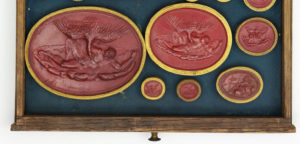
Did you ever notice the gilded frame that surrounds so many of the antique plaster or sulfur impressions of intaglios and other engraved gems? It is the gilt-edged paper that usually wraps them. If you collect or deal in the impressions from the Grand Tour era, it’s almost commonplace; it’s always there. So, who made the strips? How were they made? I’d sure like to find out.
Left: Partial image of drawer of James Tassie sulfur casts at the V&A
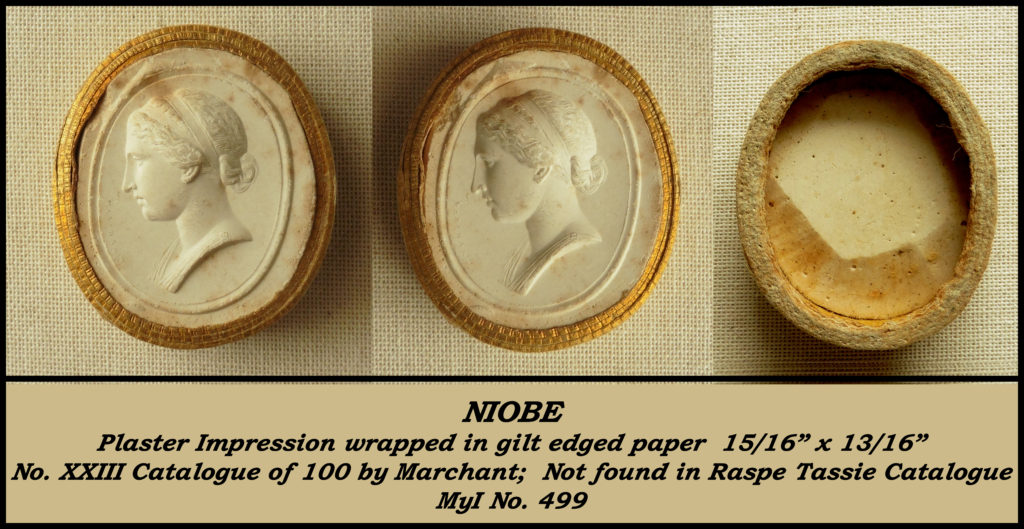
While numerous books and papers have been written about the engraved gems and their impressions, virtually nothing is available about these “frames” which, like the frame on a magnificent painting, provide a means for mounting, and, compliment the beauty of the impression.
Right: Impression in MyI collection with detail showing bottom of paper wrap. Click on image to enlarge.
Today, the gilt-edged wrapping is mentioned as an identifying element in descriptions of antique pieces. Michelle Robson of IntagliosUK on Etsy.com and Hunnypot21 on Ebay.com, when describing plaster or sulfur impressions for sale, often states, “All gilt paper wrapped and numbered as they should be.”
Bonhams, the auction house, not too long ago, when describing the lot, “A COLLECTION OF LATE 19TH CENTURY GRAND TOUR PLASTER INTAGLIOS” included the following in the narrative, “…PLASTER INTAGLIOS Of classical scenes, each wrapped in a band of yellow paper, ropetwist gilt edge…”
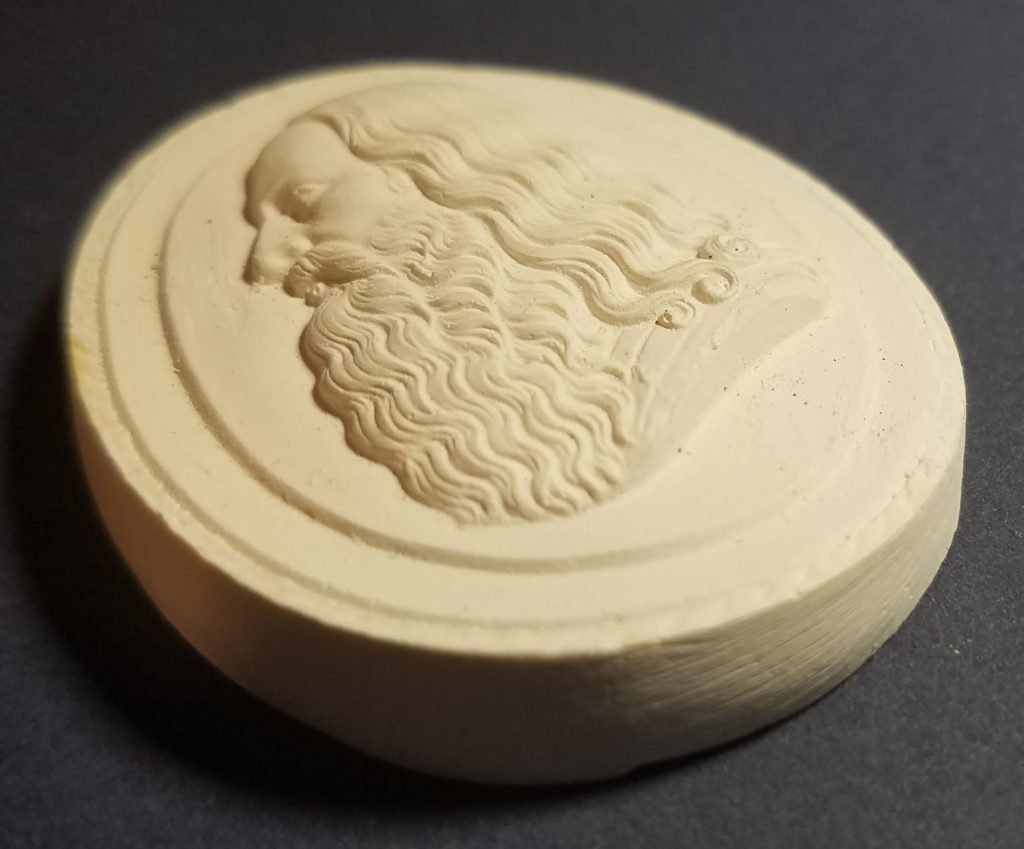
In fact, one of the features that aids in identifying a modern reproduction is, in most cases, lack of the gilt-edged paper wrap, as shown on the right
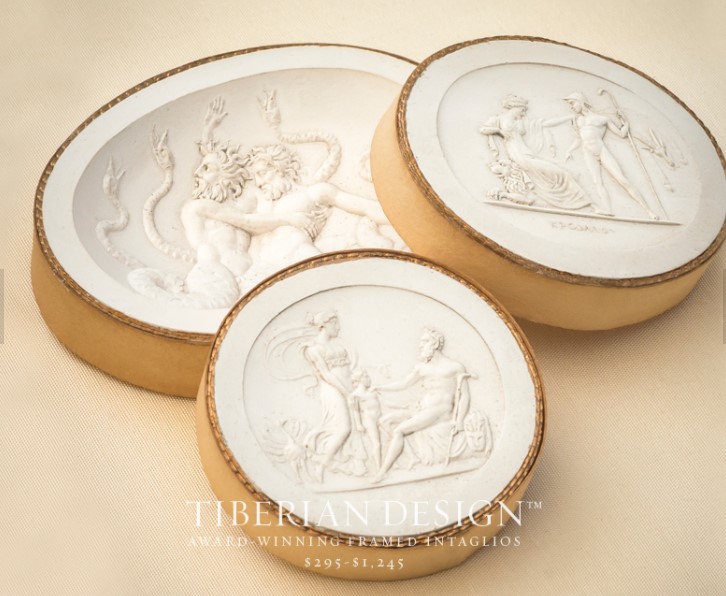
I have only found one dealer that uses modern day gilt-edged wrap on its plaster reproductions in today’s market. Tiberian Design https://www.tiberiandesign.com/ producer of “Award Winning Framed Intaglios” advertises, “…each intaglio is individually wrapped with a gilt band and antique paper–a mark of quality not found elsewhere.” Their beautiful high-end pieces are clearly marketed as reproductions. A while back I inquired about the source of the paper wraps and was told that it was confidential information.
In the Grand Tour days, the gilded edge was a selling point. In the Catalogue listing over 15,000 pieces entitled “…ANCIENT AND MODERN ENGRAVED GEMS, CAMEOS AS WELL AS INTAGLIOS … CAST IN COLOURED PASTES, WHITE ENAMEL, AND SULPHUR BY JAMES TASSIE…”, the author, R. E. Raspe, states in the price list, “Impressions in red or other colured Sulphur, with neat gilt Borders…”.
Where did this paper wrap come from? Who made it? How was it made? What was the method for attaching it to the impression? I wish I could answer those questions, but I can’t. Over my years of collecting, when, periodically, I’ve sought to find the answers to these questions, I’ve always come up empty. The closest that I’ve come are in references to “the paper strips” in the 18th and 19th century letters of James Tassie (described in more detail below), where his frustration in finding a good supplier is evident, but no real answers
So, the purpose of this blog post is two-fold:
- Set forth in one place what I do know about the paper wrapping, and
- Solicit the input and assistance of anyone who may have some insights into this topic, asking them to share their knowledge with others who may be interested, like me.
BACKGROUND:
For those who are knowledgeable about paper and its manufacture but may not be familiar with the impressions that I have mentioned, a brief bit of background may be helpful. The impressions that I refer to were plaster or sulfur casts of impressions of engraved gems. These impressions were produced throughout Europe during the Grand Tour period in the 18th and 19th centuries. They were collected as reproductions of unattainable engraved gems and as souvenirs of travel. They were also used as teaching aids in classes on the classical arts. Specimens, both singularly and in collections (sometimes numbering in the thousands), are now found in museums throughout the world. In Great Britain, the most prolific producers were James Tassie (1735-1799) and his nephew William Tassie (1777-1860).
FUNCTION:
The wrap served two purposes:
- It gave the piece a finished look, just like a frame sets off a great piece of art.
- It provided a smooth surface on the bottom of the piece which facilitated mounting on a backboard or cabinet drawer bottom.
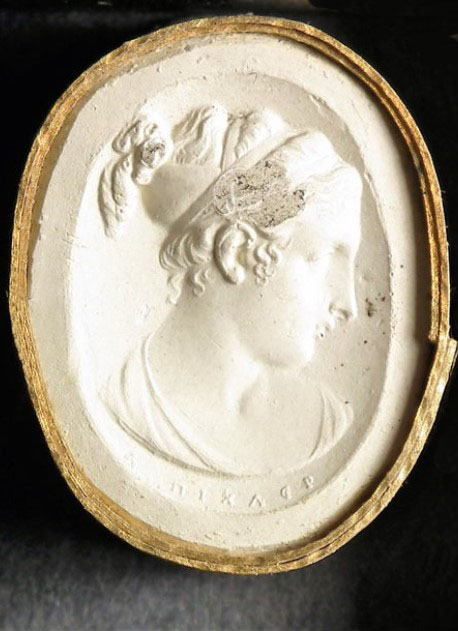
To today’s collector or dealer the paper wrap aids in the identification of the age of the impression and, possibly, gives a clue to who its maker was. Michele Robson, the prolific dealer of impressions mentioned above, periodically will mention the wrapping in her descriptions. For instance, in a past Etsy post for sale of an “Antique grand tour circa 1845 plaster intaglio cameo 24 by Franchi shows Niobe”, the description includes, “I have only had one group by this maker before but what makes me believe they are by him is the paper. All the earlier more famous makers used thicker paper, by the mid 1800’s mass produced machine made paper was getting far more common than the hand made paper wrapped around these and all the early intaglios. All gilt paper wrapped and numbered as they should be. But the paper is much thinner on these later dated ones.”
CHARACTERISTICS:
The earliest gilt-edged wrappings that I have seen are on impressions by Baron von Stosch (1691-1757) and his assistant/contemporary Cristiano Dehn (1700-1770) dating to about 1750. They could very well have been in use before that.
The most common wrap was yellow paper with a textured gilt top surface. The wraps were also produced in varied colors. They are seen both in black with the gilded edge and in black with green edge on impressions by Bartolommeo Paoletti (1758-1834) and his son Pietro (1801-1847), well-known producers of gem impressions in Rome. I’ve also seen a plain finished black edge on black paper. There probably were other combinations. In almost all cases the edge was finished in a stippled or “twisted rope” fashion. This gives the edge a “sparkly” effect, which is quite pleasing. The texture effect may also have been done so that any cracking of the gilt surface while bending the paper did not become apparent.
The paper is heavy and, in its finished state, stiff, almost brittle. The paper has a surface finish on both sides. As can be seen in the image of the “tail”, the surface of the paper is a different color than the inner material. The finish is fairly smooth, about the same as common printer paper.
Another feature found on most of the wrapped impressions is that the paper’s ends start and stop with a taper so that a bump does not appear at its beginning and end. See the image of the “tail” piece at the left. On this piece, where the wrapping has started to come lose, it can be seen that the paper is tapered over a length of about 1-1/8 in (29 mm). A guess is that, once the strip is cut to length, the ends are sanded to produce the taper, which also removes the surface finish.
There is at least one set of impressions that have a unique identifier on the wrapping. In 1839 John Tyrrell (1790-1868) bought the majority of the engraved gem collection of Prince Stanislas Poniatowski (1754-1833) that had come up for auction at Christie’s in London. Soon after his purchase Tyrrell had a catalogue printed of his collection (Explanatory Catalogue of the Proof-impressions of the Antique Gems Possessed by the Late Prince Poniatowski, and Now in the Possession of John Tyrrell, Esq…) and started to sell impressions. As a marketer, he was far ahead of his time; in addition to putting an identifying number on the wrap, he taped on a small “ad” with his name and the image of a cat. Every time someone viewed one of his impressions they knew exactly where it came from – genius! (The story of Prince Poniatowski and his gem collection is fascinating. His “fakes” pretty much were the cause of the crash of the engraved gem market in the mid 1800’s. The story is well presented by Claudia Wagner in the article “Explaining the fable and history taken from the classics: Prince Poniatowski’s Neoclassical gem collection” )
DIMENSIONS:
The paper is usually about ¼ in (6 mm) wide, although on larger pieces it can be up to 3/8 in (10 mm). It appears that Tassie only used strips of one width because variations are never mentioned in his letters. Differences in thickness of the strips can also be seen, varying very roughly from about 1/64 in ( 0.4 mm) to 3/64 in (1.2 mm)
The length of the strip would have had to vary. Some smaller impressions have barely two thicknesses of wrap while some larger ones may have up to four. The smallest impressions wrapped two times would only require a piece 4 ½ in (114 mm) long, whereas a larger one wrapped four times would require a piece over 24 in (61 cm) long!
MANUFACTURE AND ATTACHMENT:
Not being familiar with the manufacturing process of paper, I can only hazard a WAG (technical engineering term) about how the strips were made. The finished sheets of paper would have been bundled and pressed together in a vice. The gilt edge material would be applied and textured. Once dry, a strip, the width of the finished strips, would be cut from the rest of the bundle. The individual strips would then be separated using a very sharp knife.
When it was time to attach the wrap to the impression, it probably was soaked to make it pliable then wrapped around the piece and glued in place.
THE TASSIE LETTERS:
As promised earlier, included here are the references to the “paper strips” made by James Tassie in his letters. These excerpts are from, THE LETTERS OF JAMES AND WILLIAM TASSIE TO ALEXANDER WILSON 1778 TO 1826, by Duncan Thomson, Published in The Volume of the Walpole Society, Vol. 65 (2003), pp. 1-87. Accessed at https://www.jstor.org/stable/41829656
The recipient of almost all the letters, dispatched (with one exception) from London was the Glasgow stationer and bookseller, Alexander Wilson, who was an agent for their materials in Scotland. The text is true to the spelling and grammar used in the letters. I have added several comments noted as [MyI: ======].
Page 5. “… there was sent … 500 stripps of gilt paper2 that you have not mentioned the receiving of them.”
Footnote on page 5, “2. These strips of gilt paper, which caused endless difficulties, were bound round the various types of impression and the lower edge glued to the base of the drawer of the collector’s cabinet.”
[MyI: Invoices and other comments indicate that Tassie would ship the impressions and the strips of gilt paper separately; Wilson, his dealer in Glasgow, would then wrap them before mounting and selling.]
Page 11. “…sorry your obliging orders has been again so long in hand. I had no paper ready to make gilt strips…”
Page 12. “Recd your Letter of 29th last month in due Course, am very sorry your obliging order has been so long delayed. I have been much destressed for want of good paper for the gilt stripes. I had got a learge quaintity from the paper Makers, but unfortunatly turned out as bad or reather worse then thos you returned. I was under the necessity to have some made on purpose, which I hope will now be to your liking, those you returned came to me in good stead, (at any time when the paper is inclined to split we commonly rend it open and uses the one side before the other) I cannot get it to purchase under the extravagant price of one penny each stripe the length only of Common Card paper… [DLG: This is probably much more meaningful to someone familiar with the paper manufacturing process and may be helpful in further research.]
Page 20. “Unfortunately the paper I got now in hand for making gilt borders, slits in winding about the impression in the same manner as some that you returned to me sometime ago. I shall soon have a fresh quaintity made which I hope will be better…”
Page 39. “…I took to Mr Robinsons the gilt strips, to see if the length of them would suit in your parcel. They were Just a packing, and were so good to alter the form to suit the papers. It being so much more safe than bending them…”
Page 63. “…am rather in haste I must defer writing you more fully till I send the enamels – I don’t know if you would like the gilt paper borders round the enamel, but as you have often had Ens. without I shall not put any – I am Sir [MyI: Of the Tassie pastes or enamels that I have seen, there has never been one with a paper wrap, probably because, due to the nature of the paste the edges are more finished and more importantly, for the colored ones, the edges would need to be open to light to show the color better.]
That’s it. That’s all I have. I hope that a reader or two can shed some light on the questions surrounding this long lost, albeit minor, craft.
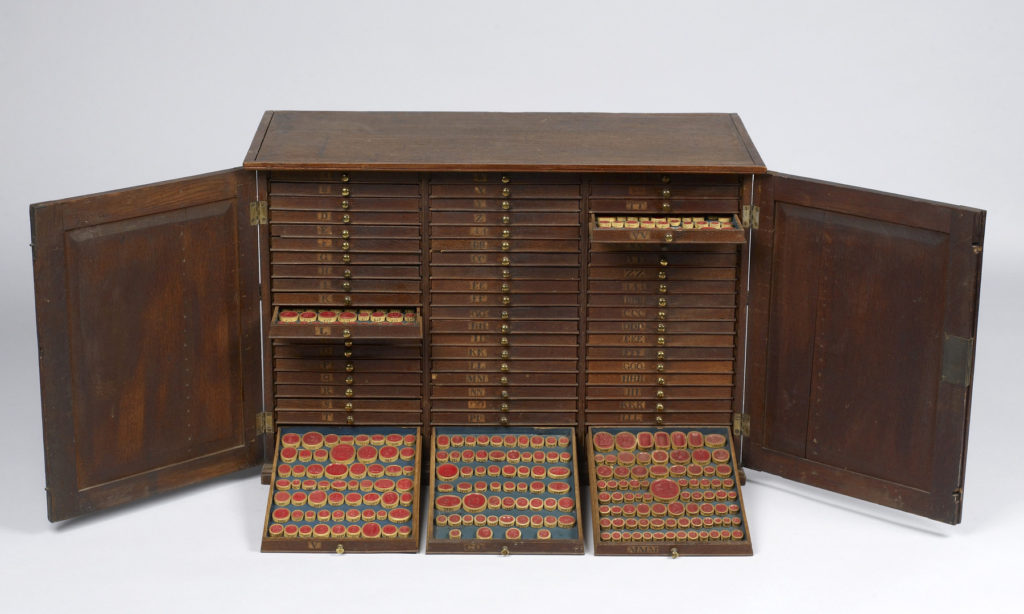
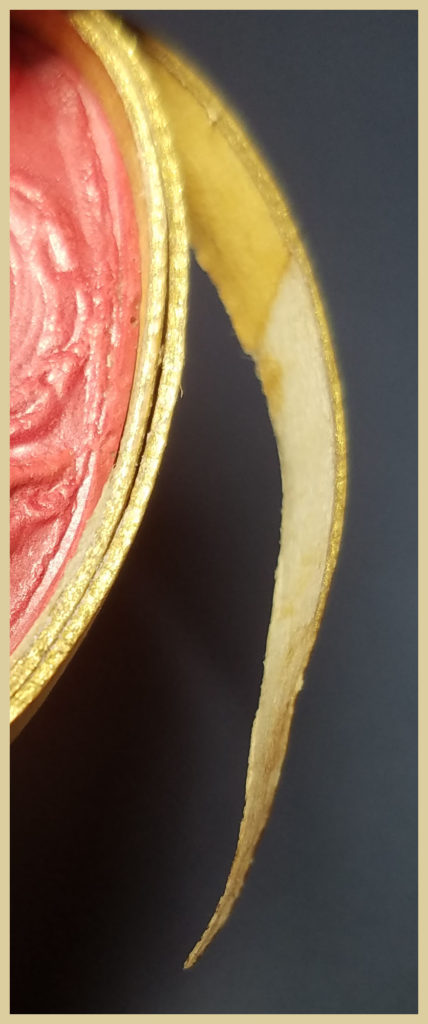

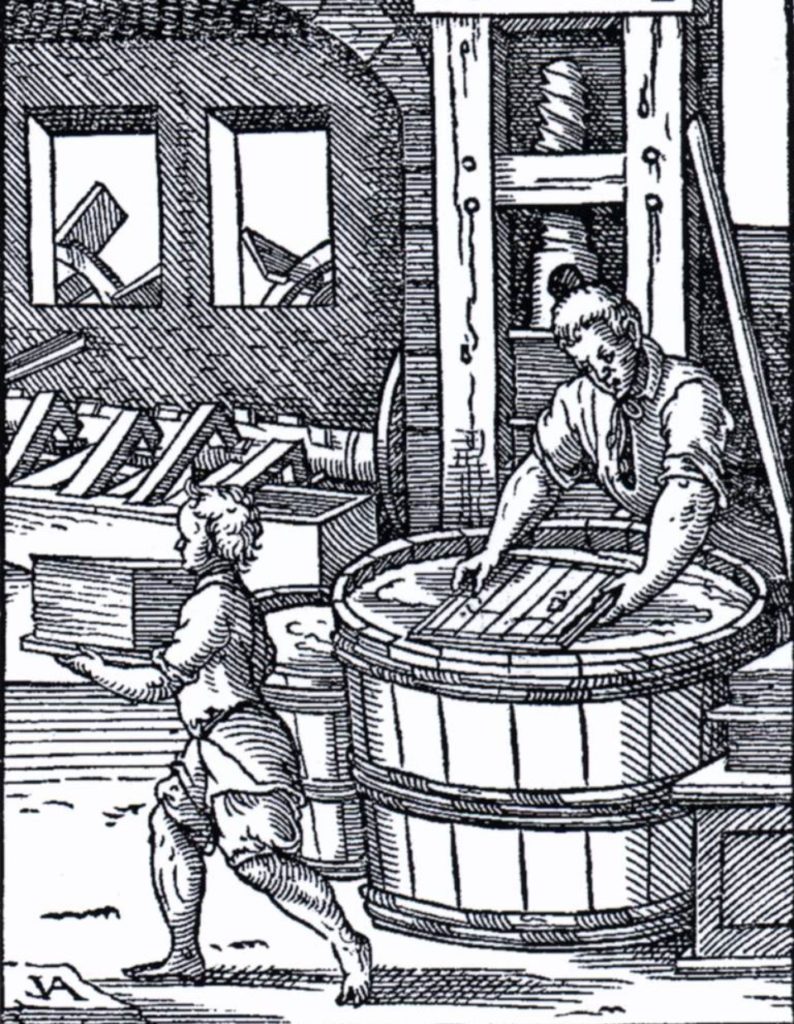
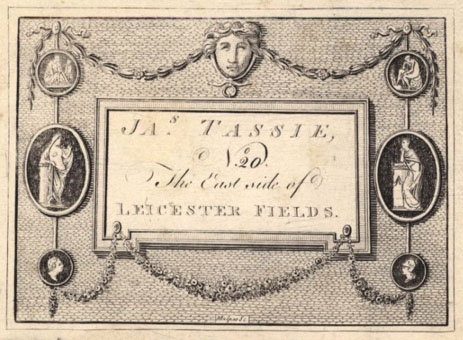
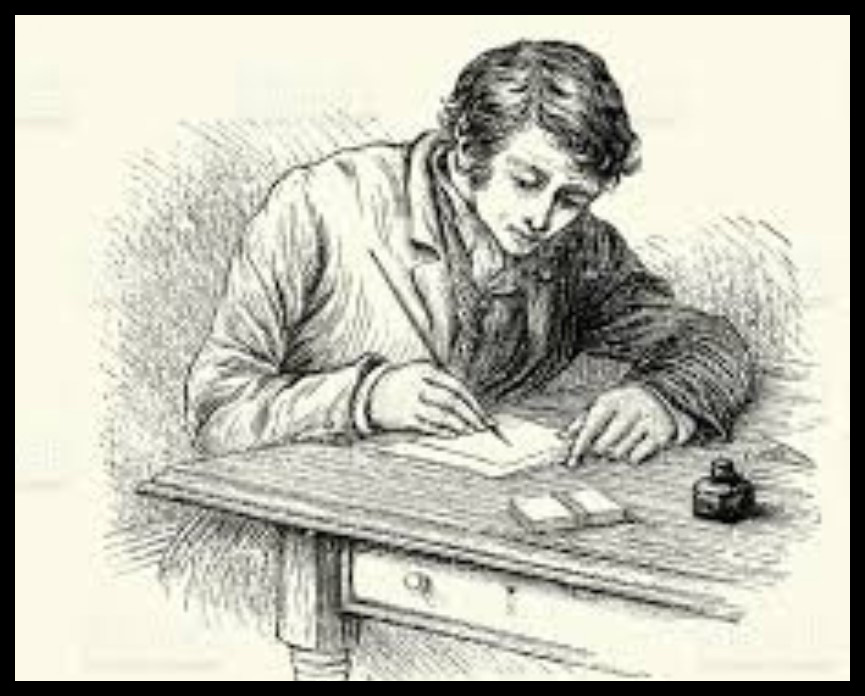
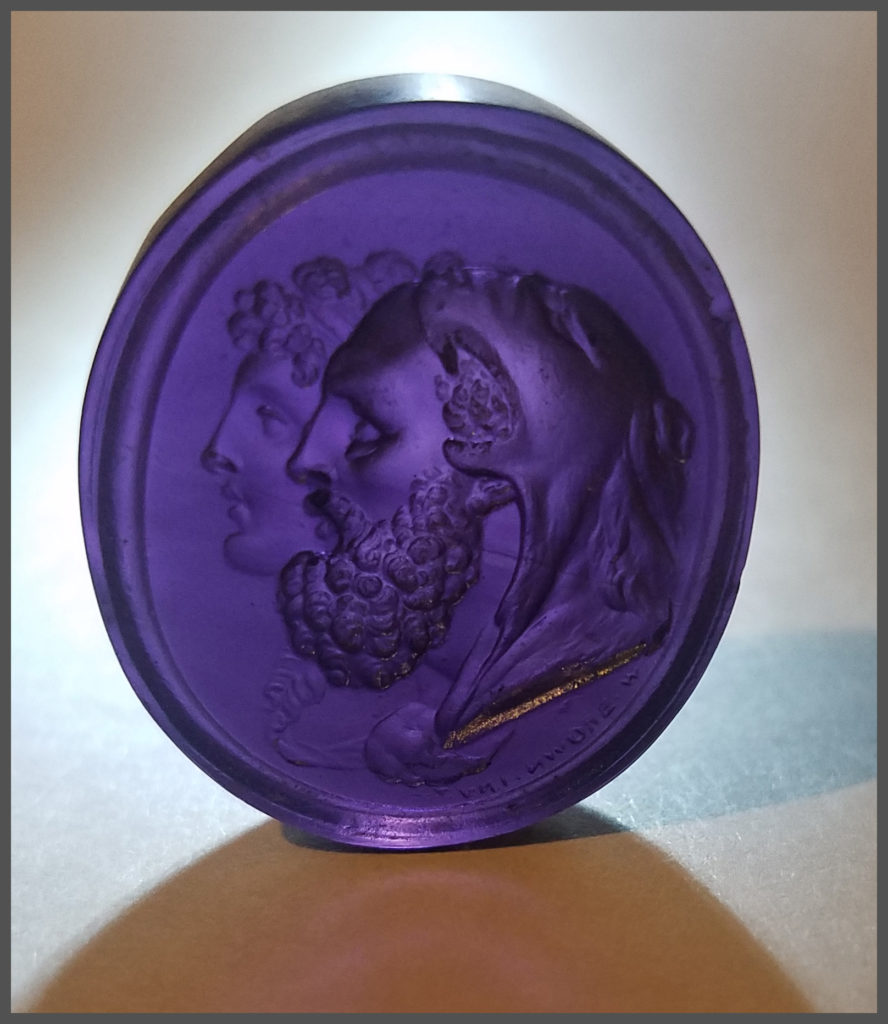
Leave a Reply